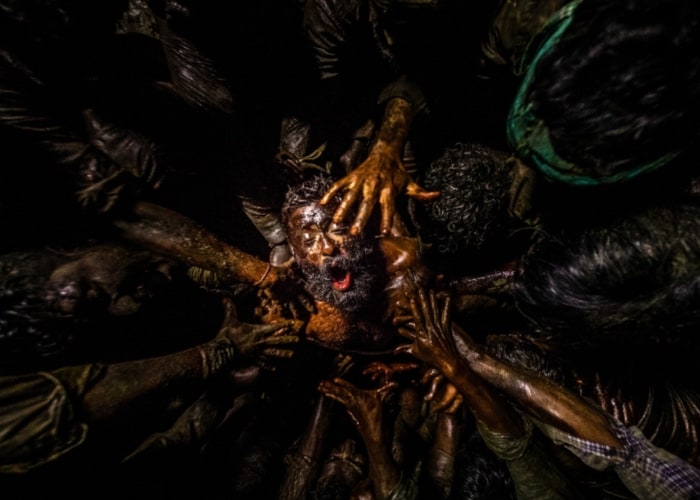
Welcome to The Prime Sublime, a weekly column dedicated to the underseen and underloved films buried beneath page after page of far more popular fare on Amazon’s Prime Video collection. We’re not just cherry-picking obscure titles, though, as these are movies that we find beautiful in their own, often unique ways. You might even say we think they’re sublime…
“Sublime /səˈblīm/: of such excellence, grandeur, or beauty as to inspire great admiration or awe”
Regular readers of this little column know that my preference for sublime finds on Prime tends to lean towards lesser known action/thrillers from the 70s, but I’m mixing it up this week with a far newer film. Jallikattu (2019) came roaring out of India last year catching quite a bit of attention on the festival circuit, but by the time it appeared on Prime the heat had simmered down. It’s deserving of so much more, though, as the film delivers a uniquely intense and thought-provoking ride from a fresh filmmaking voice.
What’s it about?
A small village in India is home to families, livelihoods, and routine, one of which is witnessed at a butcher’s stand where he kills buffaloes, cooks and carves the meat, and sells it to a hungry populace. It’s a world filled with everyday violence accepted as the norm, from the aforementioned animal carnage to the abuse of wives and neighbors by angry men, but today will be different. A buffalo mere seconds away from the slaughter escapes its executioner and runs off into the night, and as men head out in pursuit the entire village finds itself sinking into testosterone-fueled chaos.
What makes it sublime?
It’s somewhat fitting that Jallikattu‘s surface-level synopsis is actually far from the meat of the matter as the issue it’s really targeting is one buried beneath years of cultural, societal, and sexual acceptance. The film ultimately serves as a condemnation of humanity’s — specifically the males of the species — capacity for animalistic behavior and violent interactions. Yes, there’s a wild buffalo on the loose leading to panic and mayhem, but it’s the men who are responsible every step of the way for the ensuing carnage. Their actions cause friction between them which explodes in various fashions, and their chaotic attempts at corralling the beast cause far more damage than the animal ever could alone. It just wants to live, but the men, the real animals of the world, want to eat it, conquer it, and defeat it in pale offerings towards ego, vanity, and masculinity, and it’s not long before they set their sights on each other.
I mentioned the film feels like the arrival of a fresh voice, but it’s actually director Lijo Jose Pellissery’s seventh feature film — it’s his first to break through (to some degree), though, and it’s immediately clear why. From a rhythmic opening montage of people, animals, and nature set to a distinct concoction of sounds, through an ending that channels a visually stunning apocalypse of man’s own making, Pellissery shows a mastery of control over the entirety of the film’s visual and aural offerings. His team is equally deserving of praise as cinematographer Girish Gangadharan, composer Prashant Pillai, and editor Deepu Joseph help craft a world that’s both modern and ancient, familiar and foreign, absurd and horrifying.
The film isn’t all that interested in following expectations in regard to genre, but its various sidesteps into the lives and problems of numerous locals still serve a purpose. Some are played for laughs while others needle at the limits of what viewers will accept from guys just acting like guys, but while it threatens to feel disjointed or unfocused — and it will feel just that way to some viewers — it’s all in observation the Earth’s most dangerous and self-centered animal. The movie is rough and extremely raw at times, and exquisitely measured at others, but it’s all in service of a savage commentary on man’s own inevitable savagery, where sound and imagery work in tandem to build a chaotic symphony for the senses.
As a heads up to those already concerned by the prospects of a modern day film centered around an animal’s well being, the central beast’s moments of peril are a combination of sharp editing and a prosthetic effect that work to create some fairly flawless sequences. Close ups, fast edits, and pure panic make for a memorable illusion. The film’s greatest visual feast, though, comes in final ten minutes that goes for broke in sumptuous fashion with its central theme on man’s untamed aggression and its inability to mature.
And in conclusion…
Jallikattu feels unlike anything else. The easy descriptor of “animal attack movie” doesn’t really fit, but if that’s what brings viewers to its wonders so be it. The film’s turns and shifts through genres — comedy, drama, horror, art film — add to an experience few films can even approach, and even if individual pieces fall short at times there are numerous others that lift the movie right back up again. And that ending… hot damn, it’s a stunner.
Want more sublime Prime finds? Of course you do.
Related Topics: Amazon Prime, Jallikattu, The Prime Sublime
